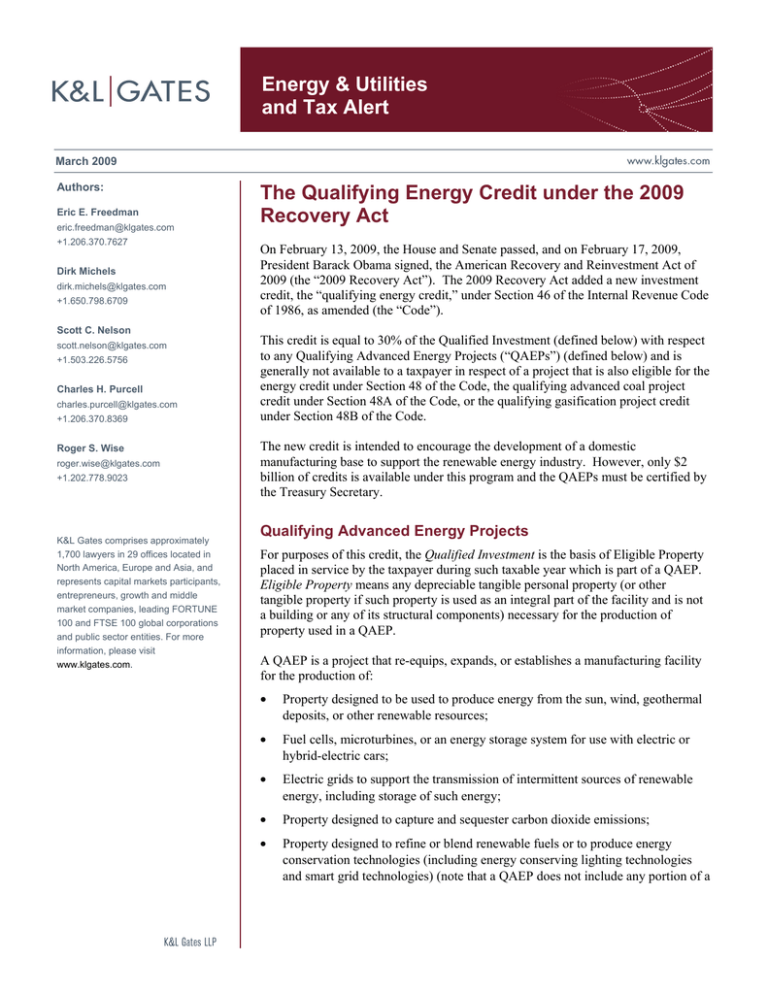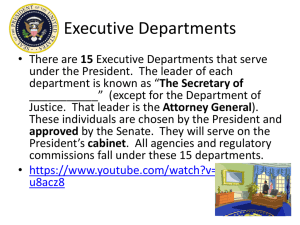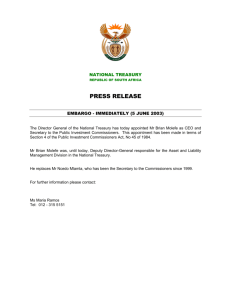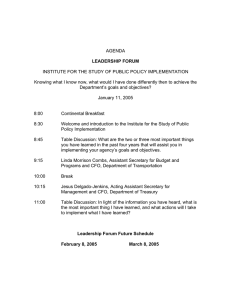
Energy & Utilities
and Tax Alert
March 2009
Authors:
Eric E. Freedman
eric.freedman@klgates.com
+1.206.370.7627
Dirk Michels
dirk.michels@klgates.com
+1.650.798.6709
Scott C. Nelson
scott.nelson@klgates.com
+1.503.226.5756
Charles H. Purcell
charles.purcell@klgates.com
+1.206.370.8369
Roger S. Wise
roger.wise@klgates.com
+1.202.778.9023
K&L Gates comprises approximately
1,700 lawyers in 29 offices located in
North America, Europe and Asia, and
represents capital markets participants,
entrepreneurs, growth and middle
market companies, leading FORTUNE
100 and FTSE 100 global corporations
and public sector entities. For more
information, please visit
www.klgates.com.
The Qualifying Energy Credit under the 2009
Recovery Act
On February 13, 2009, the House and Senate passed, and on February 17, 2009,
President Barack Obama signed, the American Recovery and Reinvestment Act of
2009 (the “2009 Recovery Act”). The 2009 Recovery Act added a new investment
credit, the “qualifying energy credit,” under Section 46 of the Internal Revenue Code
of 1986, as amended (the “Code”).
This credit is equal to 30% of the Qualified Investment (defined below) with respect
to any Qualifying Advanced Energy Projects (“QAEPs”) (defined below) and is
generally not available to a taxpayer in respect of a project that is also eligible for the
energy credit under Section 48 of the Code, the qualifying advanced coal project
credit under Section 48A of the Code, or the qualifying gasification project credit
under Section 48B of the Code.
The new credit is intended to encourage the development of a domestic
manufacturing base to support the renewable energy industry. However, only $2
billion of credits is available under this program and the QAEPs must be certified by
the Treasury Secretary.
Qualifying Advanced Energy Projects
For purposes of this credit, the Qualified Investment is the basis of Eligible Property
placed in service by the taxpayer during such taxable year which is part of a QAEP.
Eligible Property means any depreciable tangible personal property (or other
tangible property if such property is used as an integral part of the facility and is not
a building or any of its structural components) necessary for the production of
property used in a QAEP.
A QAEP is a project that re-equips, expands, or establishes a manufacturing facility
for the production of:
•
Property designed to be used to produce energy from the sun, wind, geothermal
deposits, or other renewable resources;
•
Fuel cells, microturbines, or an energy storage system for use with electric or
hybrid-electric cars;
•
Electric grids to support the transmission of intermittent sources of renewable
energy, including storage of such energy;
•
Property designed to capture and sequester carbon dioxide emissions;
•
Property designed to refine or blend renewable fuels or to produce energy
conservation technologies (including energy conserving lighting technologies
and smart grid technologies) (note that a QAEP does not include any portion of a
Energy & Utilities and Tax Alert
project for the production of any property that is
used in the refining or blending of any nonrenewable transportation fuel);
•
•
New qualified plug-in electric drive cars,
qualified plug-in electric vehicles, or
components which are designed specifically for
use with such vehicles, including electric
motors, generators, and power control units; and
Other advanced energy property designed to
reduce greenhouse gas emissions as determined
by the Treasury Secretary.
Certification
To claim this credit, a QAEP must be certified by
the Treasury Secretary under a program established
in consultation with the Secretary of Energy within
the six-month period following enactment of the
2009 Recovery Act (the “QAEP Program”). The
new Code section establishes certain time frames
within which the QAEP is to be certified and placed
in service, as follows:
•
First, the applicant must submit an application
meeting the requirements of the QAEP Program
within two years after the date of the
establishment of the QAEP Program.
•
Upon certifying an application, the Treasury
Secretary will publicly disclose the identity of
each applicant and the amount of the credit with
respect to such applicant.
•
Then, the applicant has one year from the date
the application is accepted to provide evidence
to the Treasury Secretary that the requirements
of the certification have been met.
•
After the applicant receives certification from
the Treasury Secretary, the applicant has three
years to place the project in service; otherwise,
the certification will no longer be valid.
In determining whether to certify a QAEP, the
Treasury Secretary will consider only projects that
have a reasonable expectation of commercial
viability and that:
•
will provide the greatest domestic job creation
(both direct and indirect) during the credit
period;
•
will provide the greatest net impact in avoiding
or reducing air pollutants or anthropogenic
emissions of greenhouse gases;
•
have the greatest potential for technological
innovation and commercial deployment;
•
have the lowest levelized cost of generated or
stored energy, or of measured reduction in
energy consumption or greenhouse gas
emission (based on costs of the full supply
chain); and
•
have the shortest project time from certification
to completion.
Within the next four years, the Treasury Secretary
will review the credits allocated and may reallocate
credits if he determines that (i) there is an
insufficient quantity of qualifying applications for
certification pending at the time or (ii) any
certification has been revoked because the project
subject to the certification has been delayed as a
result of third party opposition to or litigation
against the proposed project. If the Treasury
Secretary determines that credits are available for
reallocation, the Treasury Secretary is authorized to
conduct an additional program for applications for
certification.
K&L Gates comprises multiple affiliated partnerships: a limited liability partnership with the full name K&L Gates LLP qualified in Delaware and
maintaining offices throughout the U.S., in Berlin and Frankfurt, Germany, in Beijing (K&L Gates LLP Beijing Representative Office), and in
Shanghai (K&L Gates LLP Shanghai Representative Office); a limited liability partnership (also named K&L Gates LLP) incorporated in England and
maintaining our London and Paris offices; a Taiwan general partnership (K&L Gates) which practices from our Taipei office; and a Hong Kong
general partnership (K&L Gates, Solicitors) which practices from our Hong Kong office. K&L Gates maintains appropriate registrations in the
jurisdictions in which its offices are located. A list of the partners in each entity is available for inspection at any K&L Gates office.
This publication is for informational purposes and does not contain or convey legal advice. The information herein should not be used or relied upon
in regard to any particular facts or circumstances without first consulting a lawyer.
©2009 K&L Gates LLP. All Rights Reserved.
March 2009
2







